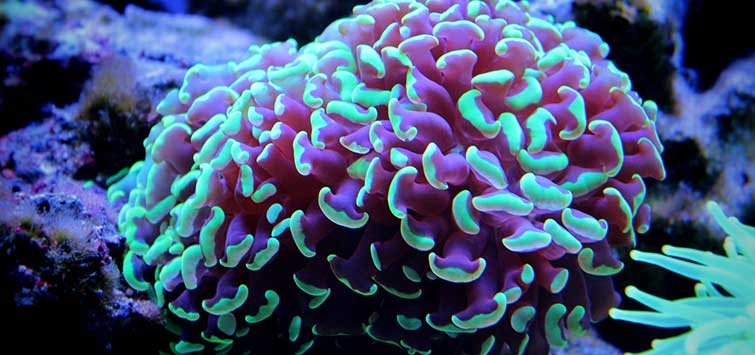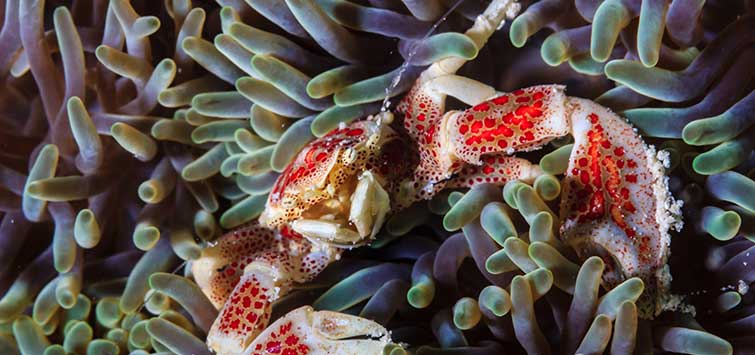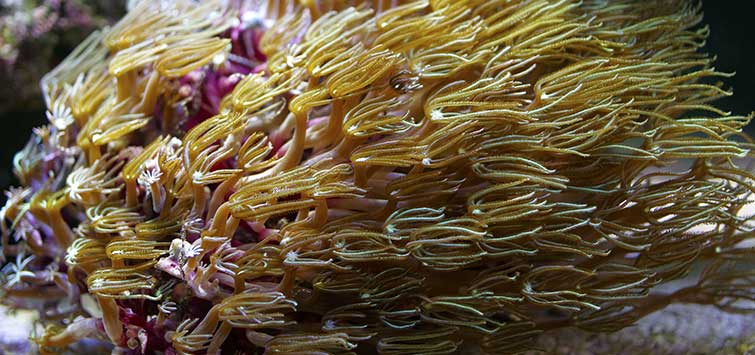The Reefer: A Look at Stony Coral Colonialism and Skeletal Form
Author: James W. Fatherree, MSc
Stony corals are called “stony” because they build a variety of hard skeletons, some of which are entirely internal while others are only partially covered by living tissue. They accomplish this by combining carbon dioxide with calcium taken from sea water to produce a solid compound called aragonite (CaCO3).
This stuff is the same compound used by snails, clams, and many other invertebrates that build hard parts, but it’s not the same thing that your bones of made of—that’s calcium phosphate rather than calcium carbonate.
These hard calcium carbonate skeletons also come in a great variety of forms, as some corals build simple disc-shaped skeletons while others create fancier branching forms and several others. These forms depend on how various corals are put together and where they are located, as they can live as individuals or in colonies and in many different environments. This month we’ll look at how these factors are tied to skeletal form, and you’ll see why many stony corals are built the way they are.
Solitary Stonies
First of all, a single stony coral animal, which is called a polyp, has a simple soft body, a hard skeleton, some feeding tentacles, a mouth and stomach, and not a lot else. These live as solitary individuals, unattached to other corals, with examples being the plate corals (Fungia and Heliofungia) and the doughnut corals (Cynarina). In some cases the hard skeleton is completely internal, being covered by living tissue, but some do have an exposed base that protrudes from the soft body. From here things get more complicated, though.
Coral Colonialism
Most stony corals have the ability to form simple to complex colonies, which are made up of any number of polyps that share a common skeleton. Examples of simple colonial corals are the trumpet coral (Caulastrea) and the branching forms of the frogspawn, hammer, and torch corals (Euphyllia).
These colonies start with a single polyp forming its own skeleton, which then grows and splits into two or more polyp-tipped branches. Each of these will then grow and split into more polyp-tipped branches, and so on, with the skeletal branches being mostly exposed and the polyp occupying only the upper end of each one. This eventually leaves the polyp on the tip of each branch isolated from the other polyps, as there’s no connection between the living tissues of one polyp and the tissues of any of the neighboring polyps on the other branches.
Branches
It’s also important to note that in the case of the trumpets and other similar stony corals, if there’s any damage to the exposed part of the skeleton the polyps aren’t able to make any repairs from the top of a branch. The polyps are incapable of thickening the exposed parts of the skeleton, either. So once a branch is formed by a polyp and left exposed it cannot be strengthened in any way. Thus, if a colony grows to a relatively large size, it must rely on the small original branches at the bottom of the colony to support it. This means that colonies are only going to get so big before they start breaking apart under their own weight, which restricts how large they’ll ever get.
Common Skeleton
Next are the stony corals that have clearly defined, individual polyps connected together to some degree by living tissue rather than being independent. All of the polyps share a common skeleton, with none of it being exposed (except where it’s attached to the bottom).
Instead, all of the polyps are connected by a thin layer of tissue, which envelops all surfaces of the skeleton. Or the polyps are actually in direct contact with each other and are distinct, but lack any spaces between each other. In either case, this allows all of the polyps to share nutrients with each other via the interconnecting tissue, and new skeletal material can also be added to all parts of the colony.
Food
If the polyps are interconnected in this way, when one captures particulate foods and/or receives good lighting, all of the surrounding polyps can also benefit. This means that each of the polyps doesn’t have to always acquire all of the food it needs, as they all share what they get. It also means that if some parts of a colony become shaded by new growth overhead, they won’t necessarily die from the lack of light; the polyps that are still in the sun can supply them with enough nutrients to stay healthy.
Skeletal Material
If the whole skeleton is covered with flesh, and new skeletal material can be added to any point on the whole skeleton, then as the colony grows upward and outward the base of the colony can be thickened and strengthened, too. This means the area of attachment to the sea floor can also be increased. These two things allow many colonial stony corals, such as the elkhorn and staghorn corals (Acropora), to grow especially large branching colonies that are durable enough to withstand strong currents and waves without being broken apart or dislodged from the sea floor.
Colony Building
This sort of interconnection also allows many stony corals to form massive colonies, which are unbranched in form. Star and boulder corals (like Dichocoenia and Favites) are good examples, as they can build large, flat to roughly spherical, colonies. These can also add skeletal material all over, which means that a round colony can stay round as it continually gets bigger. At the same time the polyps multiply on the surface of the skeleton so that there’s no more space between the polyps of a large colony than there is between those of a small colony.
Integrated Polyps
Lastly are the stony corals that have even more tightly integrated polyps with no clear beginning or end. Rather than having distinct polyps that are connected together, these have ones that blend into each other and have no discernable boundaries.
The polyps of such corals (like Diploria) often form massive brain-like colonies with meandering grooves on their surfaces, and these grooves are lined by the polyps’ tentacles with their thin elongated mouths in the middle. These corals really appear to be something other than colonies of joined polyps. And again, they can add skeletal material to any point on the skeleton, like the boulder corals.
Water Depth
With those basics covered, now we can look at how water depth and wave activity can affect growth form. Whether a coral will be solitary, colonial with polyps only on branch tips, or more integrated and branching is determined by genetics, but these two environmental factors can also play a major role in the overall form a coral develops.
Sunlight
Water depth is a factor due to the intensity and scattering/reflection of light in shallower water and the lack of intensity and scattering/reflection in deeper water. In shallow water, corals can take on a wide range of shapes and still get plenty of light simply because sunlight is so bright, but there’s more to it than just intensity.
The refraction of sunlight by waves at the surface has the effect of bending light rays so that they’re scattered in all directions while remaining intense. And sunlight is also reflected upwards from shallow bottoms in many areas, particularly if the substrate is lightly colored (like white sand). On top of that, the daily travel of the sun across the sky means that light will be coming down from different directions. This means corals living near the surface can get sunlight from many directions, rather than just from directly above.
Corals generally grow faster on the surfaces where incoming sunlight is most intense, and in such shallow waters many corals receive sufficient light on all of their surfaces to grow equally well in almost all directions. If you think about this, if a coral could get exactly the same amount of sunlight over its entire skeleton, it could grow a perfectly round skeleton, or one that looks like a spherical snowflake with perfectly symmetrical branches. (Of course there are other influences, and I am being overly simplistic here, but I’m sure you get the idea.)
On the other hand, the deeper the water the darker it gets, and the available light comes more and more from only one direction, which is straight up. So many corals that live in relatively deep waters have a shape appropriate for gathering as much of the available light as possible, meaning most are rather flat. In deeper waters very few corals can take on a spherical form or have a vertical orientation. Instead most have a flattened form that’s parallel to the surface and perpendicular to the incoming light in order to capture all the sunlight it can. Yes, there are corals that live in between the surface waters and deeper waters, and a few corals that seem to ignore these general rules, but for the most part the trend is deeper equals flatter.
“Flexibility”
Now the neat thing is that we can find these different growth forms not just amongst different species of stony corals, but amongst colonies of the same species, as well. Some corals are actually rather “flexible,” and I don’t mean that they can be bent; the term here means that their overall growth form isn’t pre-determined genetically but rather can change to suit different situations.
For example, in shallow waters many colonial stony corals can form colonies that are relatively large and round, but in deeper water the same species may develop a flatter form to better suit the situation. At the greatest depths that reef corals can live, colonies of boulder-shaped species in particular may grow as large, flat, encrusting sheets over the substrate. So colonies from shallow waters may look absolutely nothing like those from deep waters, and without a close inspection it would be easy to mistake them for two different species.
Wave Activity
Aside from changes in the amount and direction of sunlight, wave activity is also a very important shaping factor in an entirely different way. Many areas of open water reefs are regularly subjected to impacts by very strong waves, while other areas such as back-reef lagoons are not. In fact, waters in many such places are actually quite calm with the exception of the tides and an occasional storm, as the front area of a reef can protect the back area. Only certain stony corals will be found in certain environmental conditions, but the more flexible species can build appropriately shaped colonies to deal with these variable waters.
High Wave Activity
Corals that live in areas of high wave energy, such as the boulder-shaped corals and robust branched corals, have heavier, stronger skeletons to help prevent skeletal breakage when waves crash against them. Likewise, encrusting corals that overgrow surfaces in flat sheets can withstand almost any degree of punishment. Overall, exposed corals living in such high-energy environments also tend to be less fleshy and have smaller polyps.
Low Wave Activity
Conversely, corals that live in more sheltered areas often have relatively large, fleshy bodies that swell up and extend well outside the boundaries of their skeletons. Very strong waves could easily tear them to shreds, so they aren’t going to be found in areas where they could be subjected to such forces. Instead they’re found in lower energy areas away from such strong wave activity, or in unexposed areas where they’re in wave “shadows” behind or under some protective structure.
Finely branching forms of stony corals are also common in calmer areas, as are those corals that have relatively thin, leafy or wall-shaped skeletons, which could also be decimated in higher-energy environments.
Flexible Corals
Then there are the flexible corals. Just as some species can change forms with increasing depth, many corals such as the cat’s paw (Pocillopora) are just as well known for their ability to change form in response to wave energy. Colonies in high-energy areas are found with relatively few but very heavy branches, while colonies of the same species from calmer areas have much thinner, more numerous branches. There are also intermediates, which live in areas of moderate current.
Other Factors
There are numerous combinations of these environmental conditions that affect what will live where and exactly what it will look like, as there can be corals in deep and calm waters, shallow and calm waters, shallow and rough waters, etc. There are also a few other factors, such as what types of coral predators are found in different areas, how often an area is hit by major storms (like typhoons), and how clear or murky the waters may get due to suspended sediments.
However, with the information you have now you should nevertheless be able to look at a stony coral and have a basic understanding of why it looks the way it does, and maybe even the type of environment it came from.
Keep in mind that this knowledge can be useful when trying to figure out where to place a coral in a reef aquarium. For example, corals that are boulder-shaped will thrive if they receive light from all directions, while those that are flattened in form will only need light from directly above.
Colonies with heavier branches are built for life in strong currents; those with fine branches are built for less current; and colonial or solitary types that have large, fleshy bodies prefer even weaker currents. By taking these sorts of observations into consideration and thinking about what you see, you can keep your corals in the best location and under the best conditions, in turn increasing your chances of success.




